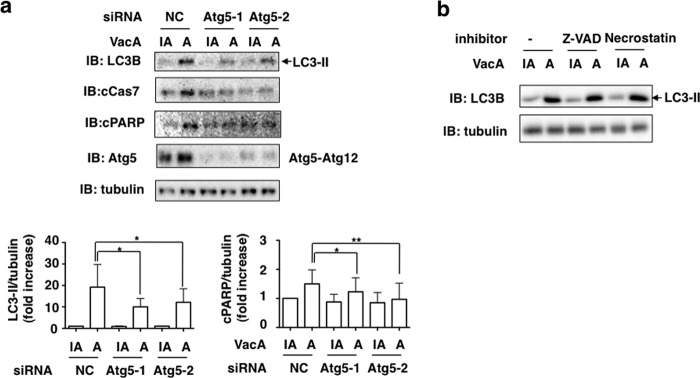FIGURE 8.
Effects of Atg5 silencing, Z-VAD-fmk, and Necrostatin-1 on VacA-induced LC3-II generation and PARP cleavage. a, the indicated siRNA-transfected AZ-521 cells were incubated with 120 nm heat-inactivated (IA) or wild-type VacA (A) for 8–10 h at 37 °C and the cell lysates were subjected to immunoblotting (IB) with anti-LC3B, anti-cleaved PARP, or anti-Atg5 antibodies. α-Tubulin, as a loading control. A blot representative of three separate experiments is shown. Quantification of VacA-induced LC3-II or PARP cleavage (cPARP) in the indicated siRNA-transfected AZ-521 cells was performed by densitometry (bottom panel). Data are presented as mean ± S.D. and significance is (*) p < 0.05 (n = 5) and (**) p < 0.01(n = 5). b, AZ-521 cells were pretreated with 50 μm Z-VAD-fmk (Z-VAD) or 50 μm Necrostatin-1 (Necrostatin) for 30 min, and then 120 nm heat-inactivated or wild-type VacA were added to cells. After a 10-h incubation at 37 °C, cell lysates were analyzed by Western blotting using antibodies against LC3B and cleaved PARP. α-Tubulin served as a loading control. Data are representative of three separate experiments. Quantification of VacA-induced PARP cleavage (cPARP) levels in the indicated siRNA-transfected AZ-521 cells was performed by densitometry (bottom panel). Data are presented as mean ± S.D. and significance is (*) p < 0.01 (n = 3).

